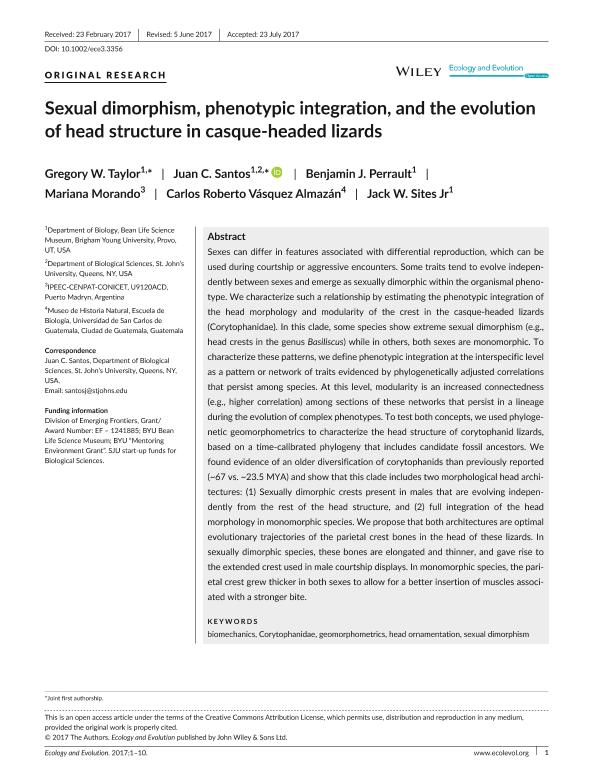Mostrar el registro sencillo del ítem
dc.contributor.author
Taylor, Gregory W.
dc.contributor.author
Santos, Juan C.
dc.contributor.author
Perrault, Benjamin J.
dc.contributor.author
Morando, Mariana

dc.contributor.author
Vásquez Almazán, Carlos Roberto
dc.contributor.author
Sites, Jack W.
dc.date.available
2018-08-06T00:55:00Z
dc.date.issued
2017-09
dc.identifier.citation
Taylor, Gregory W.; Santos, Juan C.; Perrault, Benjamin J.; Morando, Mariana; Vásquez Almazán, Carlos Roberto; et al.; Sexual dimorphism, phenotypic integration, and the evolution of head structure in casque-headed lizards; Wiley Blackwell Publishing, Inc; Ecology and Evolution; 7; 21; 9-2017; 8989-8998
dc.identifier.issn
2045-7758
dc.identifier.uri
http://hdl.handle.net/11336/54225
dc.description.abstract
Sexes can differ in features associated with differential reproduction, which can be used during courtship or aggressive encounters. Some traits tend to evolve independently between sexes and emerge as sexually dimorphic within the organismal phenotype. We characterize such a relationship by estimating the phenotypic integration of the head morphology and modularity of the crest in the casque-headed lizards (Corytophanidae). In this clade, some species show extreme sexual dimorphism (e.g., head crests in the genus Basiliscus) while in others, both sexes are monomorphic. To characterize these patterns, we define phenotypic integration at the interspecific level as a pattern or network of traits evidenced by phylogenetically adjusted correlations that persist among species. At this level, modularity is an increased connectedness (e.g., higher correlation) among sections of these networks that persist in a lineage during the evolution of complex phenotypes. To test both concepts, we used phylogenetic geomorphometrics to characterize the head structure of corytophanid lizards, based on a time-calibrated phylogeny that includes candidate fossil ancestors. We found evidence of an older diversification of corytophanids than previously reported (~67 vs. ~23.5 MYA) and show that this clade includes two morphological head architectures: (1) Sexually dimorphic crests present in males that are evolving independently from the rest of the head structure, and (2) full integration of the head morphology in monomorphic species. We propose that both architectures are optimal evolutionary trajectories of the parietal crest bones in the head of these lizards. In sexually dimorphic species, these bones are elongated and thinner, and gave rise to the extended crest used in male courtship displays. In monomorphic species, the parietal crest grew thicker in both sexes to allow for a better insertion of muscles associated with a stronger bite.
dc.format
application/pdf
dc.language.iso
eng
dc.publisher
Wiley Blackwell Publishing, Inc

dc.rights
info:eu-repo/semantics/openAccess
dc.rights.uri
https://creativecommons.org/licenses/by-nc-sa/2.5/ar/
dc.subject
Biomechanics
dc.subject
Corytophanidae
dc.subject
Geomorphometrics
dc.subject
Head Ornamentation
dc.subject
Sexual Dimorphism
dc.subject.classification
Otras Ciencias Biológicas

dc.subject.classification
Ciencias Biológicas

dc.subject.classification
CIENCIAS NATURALES Y EXACTAS

dc.title
Sexual dimorphism, phenotypic integration, and the evolution of head structure in casque-headed lizards
dc.type
info:eu-repo/semantics/article
dc.type
info:ar-repo/semantics/artículo
dc.type
info:eu-repo/semantics/publishedVersion
dc.date.updated
2018-05-23T13:33:46Z
dc.journal.volume
7
dc.journal.number
21
dc.journal.pagination
8989-8998
dc.journal.pais
Estados Unidos

dc.description.fil
Fil: Taylor, Gregory W.. University Brigham Young; Estados Unidos
dc.description.fil
Fil: Santos, Juan C.. St John's University; Estados Unidos. University Brigham Young; Estados Unidos
dc.description.fil
Fil: Perrault, Benjamin J.. University Brigham Young; Estados Unidos
dc.description.fil
Fil: Morando, Mariana. Consejo Nacional de Investigaciones Científicas y Técnicas. Centro Científico Tecnológico Conicet - Centro Nacional Patagónico. Instituto Patagónico para el Estudio de los Ecosistemas Continentales; Argentina
dc.description.fil
Fil: Vásquez Almazán, Carlos Roberto. Universidad de San Carlos de Guatemala; Guatemala
dc.description.fil
Fil: Sites, Jack W.. University Brigham Young; Estados Unidos
dc.journal.title
Ecology and Evolution
dc.relation.alternativeid
info:eu-repo/semantics/altIdentifier/url/https://onlinelibrary.wiley.com/doi/abs/10.1002/ece3.3356
dc.relation.alternativeid
info:eu-repo/semantics/altIdentifier/doi/http://dx.doi.org/10.1002/ece3.3356
dc.relation.alternativeid
info:eu-repo/semantics/altIdentifier/url/https://www.ncbi.nlm.nih.gov/pmc/articles/PMC5689487/
Archivos asociados
